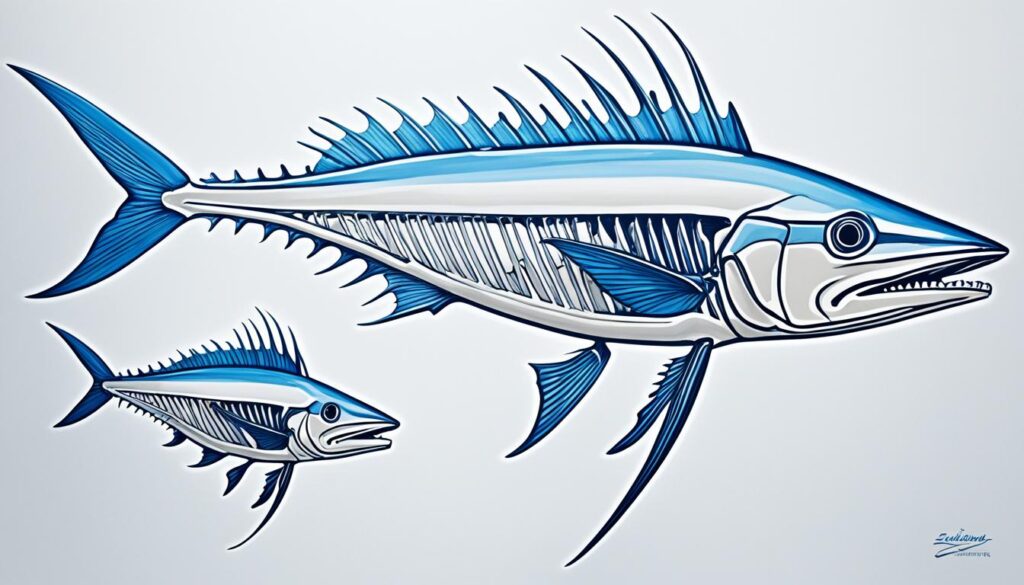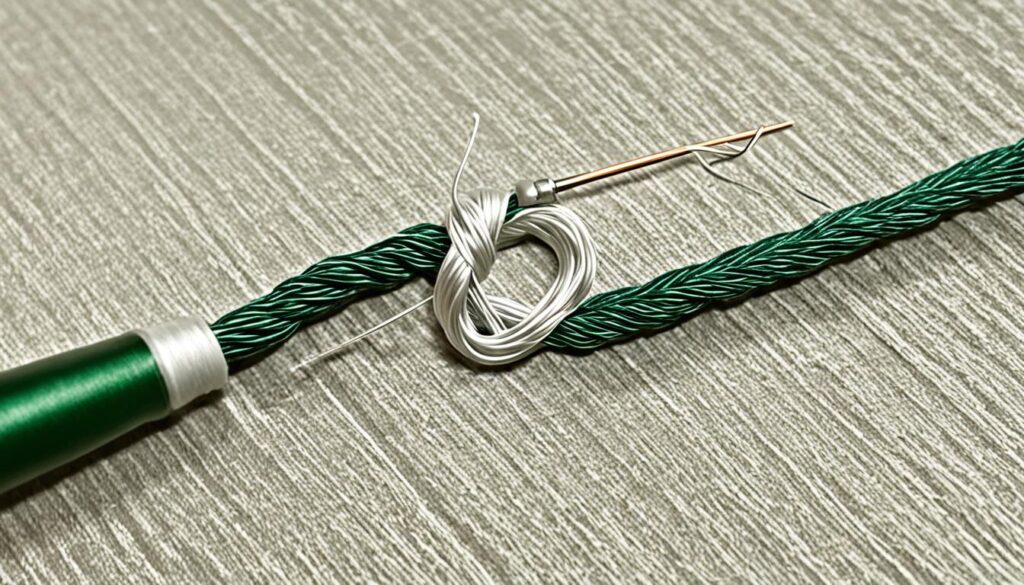“As an Amazon Associate I earn from qualifying purchases.”
Key Takeaways
- The foundation of successful fly fishing lies in mastering essential fishing knots.
- A variety of knots, such as the Improved Clinch Knot and Palomar Knot, are crucial for securing larger catches.
- Strong fishing knots enhance rig durability and accommodate different fishing conditions.
- Types of fishing knots learned from fishing knot tutorials are pivotal in setting up gear efficiently.
- Embracing knot-tying intricacies enriches your overall fly fishing experience.
The Importance of Fishing Knots in Angling
Knots are key in fishing to keep your gear together. They help during casting, retrieving, and when you catch a fish. Knowing different knot tying techniques makes your gear more stable and improves fishing fun. It’s crucial whether you’re fixing a lure, joining lines, or tying a line to a reel.The Palomar Knot is great for its ease and strength, perfect for braided lines. The Uni Knot works well for both monofilament and leader connections. It’s also known as the Hangman’s Knot.The Surgeon’s Knot shines when tying lines of different sizes. It’s reliable and doesn’t weaken the line. This is helpful for connecting lines smoothly without losing strength.For attaching lines to hooks, lures, or swivels, use the Improved Clinch Knot. But it’s not good for lines over 30lb. The Trilene Fishing Knot is versatile for snaps, swivels, hooks, and lures. This makes it great for many uses.The Berkley braid knot is crucial for braided lines. It’s strong and stops the line from slipping. This is key for keeping hooks, lures, and leaders secure.The Uni to Uni Knot is impressive. It keeps up to 90% of the line’s strength. It beats the Surgeon and Blood Knot. So, it’s a must-have for your fishing knots.Focus on your knots for better success and fun in fishing. Next time, remember even easy fishing knots can help catch big fish.Arbor Knot: Connecting Your Backing to the Reel
The Arbor Knot is top-rated for linking your backing and the reel. It’s simple but very effective. This knot keeps your line secure, no matter the catch. Knowing how to tie it means your fishing setup will be strong and last long.Why the Arbor Knot is Fundamental
The Arbor Knot is vital for fly fishing. Here’s why:- Durability: It’s the backbone of your fishing setup.
- Simplicity: It consists of just two easy knots.
- Efficiency: It keeps your line tight on the reel during big catches.

Steps to Tie an Arbor Knot
Here’s how to tie the Arbor Knot:- First Overhand Knot: Loop the backing around the reel and tie an overhand knot.
- Second Overhand Knot: Make another overhand knot on the line.
- Tighten: Pull both knots tight against the reel for security.
- Trim: Cut off extra line near the knot for tidiness.
The Nail Knot: Smooth and Reliable Connections
The Nail Knot is a standout in fly fishing for its sleek, slender design and top-notch performance. It’s great for connecting the backing to the fly line or the fly line to the leader. It ensures smooth transitions and few snags. Anglers prize the Nail Knot for being strong, dependable, and versatile across line sizes.Using the Nail Knot for Fly Fishing
The Nail Knot is key for fly fishing. It’s recommended for gentle casting and avoiding weeds and debris. This knot makes a clean link. Its design helps reduce breakage when pulling in big fish.There are special tools to make tying a Nail Knot easier. Joe Mahler, an expert in fly casting, often highlights its benefits in tutorials. It allows for smooth casts and a better fishing experience.Step-by-Step Guide to the Nail Knot
To learn the Nail Knot, just follow these steps:- Start by looping the leader around the fly line and a thin item (like a nail) six times. Keep the loops tight to each other.
- Next, thread the end of the leader through the thin item and then back through the loops.
- After that, carefully remove the thin item while pulling the leader to secure the knot. Make sure the loops don’t overlap.
- To finish, add some knot dressing and a touch of glue to make the knot smooth and durable.
| Step | Description |
|---|---|
| 1 | Wrap the leader around the fly line and a tube six times. |
| 2 | Insert the tag end into the tube and push through the coils. |
| 3 | Remove the tube and tighten the knot. |
| 4 | Dress, lubricate, and optionally add flexible cement or UV glue. |
Loop to Loop Connection: Quick and Efficient
The Loop to Loop Connection is perfect for when you have to change fly lines or leaders often. It’s designed to create a strong bond quickly and easily. Given its simple design, it saves a lot of time and stands out as one of the top fishing knots. Moreover, it’s built to slide through rod guides smoothly, making your fishing smoother.Benefits of the Loop to Loop Connection
The Loop to Loop knot has many benefits for fishermen. It enables quick changes of the fly line or leader, making fishing more efficient. This knot prevents snagging during casting and retrieval, thanks to its smooth transition. It’s versatile, strong, and useful in various fishing spots, from Trout Streams in North Georgia to New Zealand’s Tekapo Region.How to Create a Loop to Loop Connection
Creating a Loop to Loop connection is straightforward:- Place one loop over the other.
- Insert the end of the line through the loop.
- Pull to tighten.
Perfecting the Perfection Loop Knot
The Perfection Loop is a favorite among fishermen. It’s strong and helps lures and baits move well. It’s perfect for precision casting and lasts long during tough fishing.
Advantages of a Well-Tied Perfection Loop
A well-tied Perfection Loop has many benefits. It cuts through wind easily, making casting better. It’s also very strong, good for catching big fish.It also keeps your line clear of weeds and debris. Some prefer the Non-Slip Loop Knot for its strength. But the Perfection Loop is still the top choice for many.Tying the Perfect Perfection Loop
Learning the Perfection Loop is key for serious fishermen. Make a small loop and thread the end through it twice. You’ll get a strong, even knot. For a guide to tying it with fluorocarbon line, there are many online tutorials.Enhance your knot-tying skills with this comprehensive guide. It will help you master the Perfection Loop and catch more fish.The Blood Knot for Monofilament or Fluorocarbon Lines
The Blood Knot is top-notch for monofilament or fluorocarbon lines. It’s great for joining two lines of the same size. This makes a smooth link that’s key for keeping your line consistent. But why pick the Blood Knot over simpler knots?Why Choose the Blood Knot?
The Blood Knot’s strength and dependability are well-known. It has been shown to be 13% stronger than the double uni knot. Fishers like it for tying a fluorocarbon leader to a main monofilament line. This makes the line harder for fish to see near the bait. Its neat finish is a bonus, making your line look sleek.How to Execute the Blood Knot
Want to learn a top fishing knot? Here’s what to do:- Overlap two line ends by about 6 inches.
- Wrap one line’s end around the other 5-7 times, then do the same with the other line.
- Pull the ends back through the middle space you made.
- Wet the knot with spit—it helps make the knot stronger.
- Pull on all lines to tighten the knot well.
| Knot Type | Strength Comparison | Best Use |
|---|---|---|
| Blood Knot | 13% stronger than double uni knot | Mono-to-mono, fluoro-to-mono |
| Double Uni Knot | Weaker by 13% | Various line types |
The Palomar Knot: A Versatile Powerhouse
Are you searching for the top fishing knots? The Palomar Knot is your answer. It’s a favorite among bass anglers for its easy-to-tie approach and robustness. When paired with braided lines, this knot performs exceptionally well due to braided lines’ higher strength and lower stretch.
Versatility and Strength of the Palomar Knot
The Palomar Knot excels with various fishing knot types because of its versatility. It works great with braided lines that stay straight, enhancing your casting. This also helps you feel even the smallest bites, giving you an edge in tough fishing conditions.Braided lines need knots like the Palomar for their incredible strength. Plus, they are more durable against UV rays and chemicals. So, the Palomar Knot is a strong and lasting choice for any angler.Tying a Reliable Palomar Knot
The Palomar Knot is simple but very strong. Follow this fishing knot tutorial:- Double about 6 inches of the line and pass the loop through the eye of the hook.
- Tie an overhand knot with the doubled line, keeping the hook loose.
- Pass the loop over the hook, and moisten the knot before tightening to reduce friction.
- Pull both the standing line and tag end to secure the knot.
| Fishing Knot | Line Type | Strength | Use |
|---|---|---|---|
| Palomar Knot | Braided | High | Hooks, Lures |
| Uni Knot | All Types | High | Lines, Hooks |
| Alberto Knot | Braided | High | Connecting Lines |
| Double Uni Knot | All Types | High | Joining Lines |
| FG Knot | Braided | Very High | Leader to Main Line |
Improved Clinch Knot for Reliable Tackle Connections
For over a century, anglers have trusted the improved clinch knot. It’s known for being easy to tie and very versatile. You can use it whether you’re catching small fish or going after big ones like tuna. It’s a top choice for every fisherman.Benefits of the Improved Clinch Knot
The improved clinch knot is loved by many for its wide range of benefits. It’s strong enough for big game fish, holding up to 60-pound lines or more. And, it works just as well on lighter lines for smaller catches.Here’s a quick breakdown of its benefits:- Versatility: Great for all kinds of fishing.
- Reliability: It prevents the line from slipping by using larger loops.
- Ease of Use: You can tie it easily, even when your hands are cold or wet.
How to Tie the Improved Clinch Knot
Tying the improved clinch knot quickly means you can get your bait and hooks ready fast. It makes for a strong attachment that won’t let you down. Here’s what you need to do:- Thread the line through the hook eye and wrap it around the main line four times, but only if you’re using a heavier line (20-40 pounds).
- Next, pass the tag end through the little loop near the hook eye.
- With lighter lines (10 pounds or less), twist the tag end around five to seven times for a stronger knot.
- Then, pull the tag end through the bigger loops you made. This step helps avoid slippage.
- Finally, pull on both the tag end and the standing line to tighten. Always wet the knot before pulling tight.
| Line Type | Wraps Required | Use Case |
|---|---|---|
| Heavier Line (20-40 pounds) | 4 wraps | Perfect for catching bigger fish. |
| Lighter, thinner lines (10 pounds or less) | 5-7 turns | Ideal for smaller fish and delicate fishing. |
Fishing Knots: Key to Your Angling Success
Your angling success depends a lot on how well you tie fishing knots. Think of these knots as the key ingredient. They make setting up your gear and facing any situation easier. Imagine quickly learning any fishing knot, mastering different ones with no hassle.Why is learning to tie fishing knots so important? By mastering different knots, you can handle any fishing situation. Whether securing your line with a strong Arbor Knot or using a smooth Nail Knot, you’ll be ready.Getting good at knots like the Loop to Loop Connection can change your fishing game. It offers a fast Nail Knot alternative. Or try the Perfection Loop Knot for precise casts. The Blood Knot is great for joining lines, preferred by many anglers.Ending a fishing trip successfully means your gear is intact and you feel confident. Knots like the Improved Clinch Knot and the strong Palomar Knot prepare you for any adventure. The versatility of the Uni Knot and the Double Uni Knot is a must-have for anglers.Knowing your way with fishing knots is crucial. Having knowledge of various knots is like holding a key to many fishing situations. This boosts your success rate and makes fishing more enjoyable.| Fishing Knot | Primary Use | Key Benefits |
|---|---|---|
| Arbor Knot | Attaching backing to the reel arbor | Prevents slippage |
| Nail Knot | Connecting backing to fly line or fly line to leader | Smooth transitions |
| Loop to Loop Connection | Quick fly fishing setup | Efficient line switching |
| Perfection Loop Knot | Creating loop at leader’s end | Enhanced casting accuracy |
| Blood Knot | Joining monofilament or fluorocarbon lines | Strong and reliable |
| Improved Clinch Knot | Attaching lines to hooks, lures, or swivels | High usage among anglers |
| Palomar Knot | General knot for strength | Reliable performance |
| Uni Knot | Various knotting applications | Adapts to different scenarios |
| Double Uni Knot | Joining two lines | Secure connections |
Conclusion
Fishing knots tie our hopes to the excitement of catching a fish. They are not just tools; they turn fishing into an art. Learning various knots boosts your confidence and skills as an angler.Knowing simple knots, like the Improved Clinch Knot, is key. This journey of mastering knots leads to more catches and thrilling experiences. It’s a path filled with rewards and excitement.Improving your knot-tying skills for different situations is important. Whether it’s a Surgeon’s Knot or an Albright Knot, using the right one makes you more efficient. Mastering these knots makes fishing an adventure, deepening your connection to the water and its fish.FAQ
Why are fishing knots essential for anglers?
How do fishing knots affect the fly fishing setup?
What is the Arbor Knot and why is it fundamental?
How do you tie an Arbor Knot?
What makes the Nail Knot smooth and reliable?
How do you tie a Nail Knot?
What are the benefits of the Loop to Loop Connection?
How do you create a Loop to Loop Connection?
Why is the Perfection Loop Knot advantageous?
How do you tie the Perfection Loop Knot?
Why choose the Blood Knot for joining lines?
How do you execute the Blood Knot?
What makes the Palomar Knot versatile and strong?
How do you tie a reliable Palomar Knot?
What are the benefits of the Improved Clinch Knot?
How do you tie the Improved Clinch Knot?
How do fishing knots contribute to angling success?
“As an Amazon Associate I earn from qualifying purchases.”

